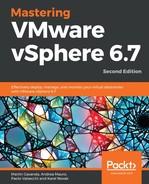FC is an entire high-speed network stack used to implement storage area networks. Starting with vSphere 6.0U2, ESXi supports 32 Gbps FC for all the supported HBA.
When using ESXi with FC SAN, follow the recommendations and best practices of both VMware and the storage vendor to avoid possible issues. Note that storage vendor specifications could be more restrictive than VMware's; for example, the HCL could be smallest or restricted on specific firmware/driver versions. In those cases, it's essential to use the vendor specifications.
On the ESXi side, you have to only plug in the supported FC HBA (with the correct firmware and drivers) and cable them properly, usually following a full fabric topology, as shown at the following diagram:

VMware may support point-to-point topologies (such as a DAS storage, for a small environment), but first you have to verify if the storage vendor supports it. After that, you only have to configure the fabric with the correct zoning at the port level or better at the World Wide Name (WWN) level (again, refer to what your storage vendor requires or recommends); and finally, the storage with the correct LUN masking to present the logical disks to the hosts. At this point, there isn't any difference, at the ESXi level, between local or remote storage: you need to format the logical disk from one host and then re-scan the datastore from all the others. That's all!
Most storage requires that each ESXi host is registered with the array, to map the hosts correctly to the arrays and also to authorize the connections (FC does not provide strict authentication capabilities). ESXi usually performs automatic host registration by sending the host's name and IP address to the array, but if you prefer to perform manual registration, you can disable the ESXi auto-registration feature by changing the advanced settings, Disk.EnableNaviReg, to 0.
FC usually does not require specific tuning at the host level, except maybe the HBA settings or the queue depth for the driver (refer to storage vendor best practices).
Since the FC device is configured before the OS is booted, you can quickly boot from the SAN using FC adapters. There is no difference when it comes to VMware vSphere configuration; all you need to do is to provide an additional, usually small, disk that will be used as a destination device in the installation procedure. This is especially handy when working with blade servers because you do not need to buy local disks just for the installation of the ESXi hypervisor.
